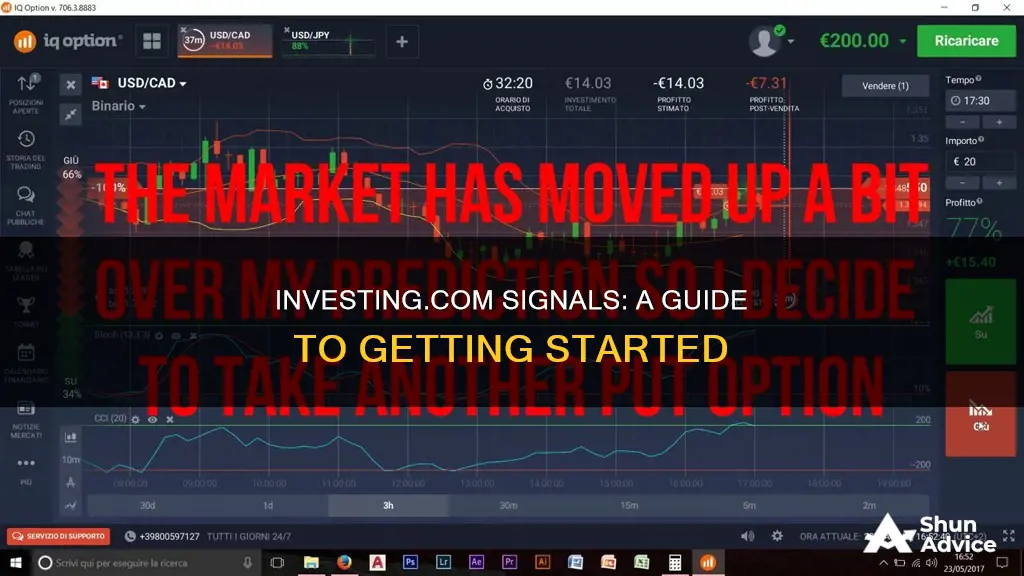
Investing.com provides in-depth professional technical analysis reports for Forex and Futures markets, as well as Forex trading signals. The website also offers useful tools such as pivot point, moving average, indicator, and chart pattern tables. These tools help traders and investors make informed decisions by providing real-time buy, sell, or neutral indications for currency pairs, indices, and stocks. These indications are based on technical indicators and are measured according to various time frames. In addition, investing.com offers educational resources, such as webinars, that cater to both beginners and experienced traders. One such webinar covers the Relative Strength Index (RSI), a popular technical indicator for trading, and provides guidance on how to spot divergence, which can signal potential trading reversals.
| Characteristics | Values |
|---|---|
| Type of Analysis | Technical |
| Instruments | Forex, Futures, Stocks, Indices, Commodities, Bonds, Crypto, ETFs |
| Tools | Pivot point, moving average, indicator, chart pattern tables, technical summary table |
| Signals | Buy, sell, or neutral |
| Indicators | Simple and exponential moving averages, key technical indicators |
| Time Intervals | Customizable |
| Alerts | Requires sign-up |
| Portfolio Features | Requires sign-up |
What You'll Learn

Using RSI indicators to spot divergence
The Relative Strength Index (RSI) is a popular tool for traders to identify potential reversals in price trends and is considered a leading indicator of price movements. RSI divergence occurs when the RSI indicator starts to reverse before the actual price does, and it can be a useful early warning signal for traders. RSI divergence can be bullish or bearish.
Bullish RSI Divergence
A bullish RSI divergence is identified when the RSI indicator shows a higher low, while the price forms a lower low. This indicates strengthening momentum and a potential buying opportunity. It suggests that the selling pressure is weakening and the buying pressure is increasing, which could lead to a price increase.
Bearish RSI Divergence
On the other hand, a bearish RSI divergence occurs when the RSI indicator shows a lower high, while the price forms a higher high. This indicates weakening momentum and a potential selling opportunity. It suggests that the buying pressure is weakening and the selling pressure is increasing, which could lead to a price decrease.
How to Use RSI Divergence
Traders can use RSI divergence as a tool to identify potential trading opportunities. It is important to combine RSI divergence with other technical indicators and analysis to confirm the signal. For example, combining RSI with candlestick strategies, MACD, or Bollinger bands can provide additional confirmation and increase the reliability of trading decisions. Additionally, it is crucial to understand the limitations of RSI and use it in the right market conditions. RSI works best in range-bound or choppy markets and may provide false signals in strongly trending markets.
Adjusting RSI Settings
The standard setting for the You may want to see also Technical indicators are mathematical patterns derived from historical data that technical traders and investors use to forecast future price trends and make trading decisions. They are used to predict future price movements by analysing historical data. There are several types of technical indicators, but the two basic types are: Traders often use several different technical indicators in tandem when analysing a security. With thousands of different options, traders must choose the indicators that work best for them and familiarise themselves with how they work. It's important to note that technical indicators should be used in conjunction with other analysis tools and strategies to make informed trading decisions. You may want to see also Candlestick patterns are a visual representation of price movements over a given time period. They are a popular form of technical analysis used by traders to make informed decisions about buying or selling assets. The patterns can be identified on a candlestick chart, which plots the open, high, low, and close prices of a security. The body of a candlestick is formed by the opening and closing prices, with the colour indicating the direction of price movement. A green or white candlestick indicates that the price closed higher than the opening price, while a red or black candlestick shows that the price closed lower. The lines above and below the body, called shadows or wicks, represent the high and low prices during the period. Different candlestick patterns provide insights into market psychology and potential future price movements. For example, long-bodied green candles suggest strong buying pressure and bullish sentiment, while long-bodied red candles indicate significant selling pressure and bearish sentiment. Short-bodied candlesticks, on the other hand, reflect a period of consolidation with little price movement. Traders also look for reversal and continuation patterns. A reversal pattern suggests that the current price trend may change, while a continuation pattern indicates that the price will likely move in the same direction. For instance, the Hammer Pattern, a single candlestick with a short body and a long lower shadow, indicates a potential reversal of a downtrend as buyers drive prices up. Candlestick patterns can be applied across various time frames and markets, including stocks, indices, futures, forex, and cryptocurrencies. They offer a straightforward way to interpret market sentiment and make informed trading decisions. You may want to see also Undervalued stocks are stocks that are trading at a price lower than their intrinsic value. This means that the market price is lower than what the stock is fundamentally worth based on factors like earnings, dividends, growth potential, and financial health. Investors seek out undervalued stocks because they believe they have been mispriced by the market and could offer an opportunity for profit when their true value is recognised and their price increases. Methodology There are a number of metrics and tools that can be used to identify undervalued stocks. One method is to use a stock screener, which allows you to filter stocks based on specific criteria. For example, you could use the InvestingPro Stock Screener tool and select 'United States' under the 'Trading Region' tab, making sure to also select the 'Primary Trading Item' option. This will give you a list of US-centric stocks that are trading on a US exchange. You can then apply additional filters to narrow down the list and identify potential undervalued stocks. For example, you could look for stocks with a solid Price-to-Earnings (P/E) Ratio between 1 and 20, and a fair value upside greater than 25%. This indicates that the stock is either undervalued or a bargain. Another strategy mentioned on Investing.com is called "Strong Upside". This strategy has four parameters to spot potential high performers. Two of these parameters are Market Cap (adjusted) and Fair Value Uncertainty. By removing these two parameters, investors can expand their list of stocks. The first remaining parameter is Fair Value Upside, which finds stocks that have a fair value of at least 10% higher than the CMP (current market price). The second parameter is based on analysts' expectations. InvestingPro+ combines targets from rating agencies, brokerage houses, etc. and calculates the average of them. If the average target is above 10% from the CMP, the stock is considered undervalued. Risks and considerations While investing in undervalued stocks can be profitable, it is not without risk. It's important to remember that stocks can be undervalued for a reason, such as declining business prospects or industry challenges. Therefore, it's crucial to conduct thorough research and consider the company's long-term potential before investing. Additionally, undervalued stocks may take time to realise their true value. Investors need to be patient and periodically reassess the stock's fundamentals and market conditions. You may want to see also Investing.com offers a comprehensive suite of tools and resources for analysing forex and futures markets. The website provides real-time technical analysis overviews for major currency pairs and futures, derived from simple and exponential moving averages, along with key technical indicators for specific time intervals. This data is automatically updated and can be customised to your preferred currency pairs and indices. The website also offers a range of educational resources, including eBooks and trading guides, to help users understand the fundamentals of forex and futures trading. These resources cover essential aspects of the markets, from introductory material to advanced strategies, ensuring that traders can make informed decisions. For instance, the Forex Trading Guide eBook provides key terms and methodologies to boost success in forex trading. It lays the foundation for understanding the forex market and offers techniques to build confidence and improve trading outcomes. Another eBook, Introduction to Technical Analysis, focuses on analysing technical trends in the forex market. It educates traders on using tools like MACDs, Stochastics, and RSI numbers to predict market movements and make better investment decisions. Additionally, the website features opinion pieces and analysis from various contributors, such as Blake Morrow and Chris Turner, who offer insights and strategies for navigating the forex market. These contributions provide diverse perspectives and ideas that can enhance a trader's decision-making process. You may want to see also Investing.com provides real-time technical analysis and forex analysis, which includes pivot points, moving averages, indicators, and chart pattern tables. This data can help investors make informed decisions about their trades. The signals on Investing.com are based on technical indicators and are designed to provide dynamic and reliable trading signals. For example, the Relative Strength Index (RSI) is a popular indicator that can help identify potential divergences between an oscillator's trend and price movement, signalling potential trend reversals. Investing.com offers a range of signals, including buy, sell, or neutral indications for currency pairs, indices, and stocks. For instance, a recent signal indicated a "Bearish Engulfing Pattern Near $2,668 Could Trigger Key Technical Reversal" for gold.Corporate Cash Investment Strategies: Maximizing Returns, Minimizing Risk

How to use technical indicators to inform trades
Cashing Out Investments: When and How to Do It

Understanding candlestick patterns
Cash Reserves: Smart Investment Strategy or Missed Opportunities?

Identifying undervalued stocks
How Much Cash Should You Keep in Your Investment Portfolio?

Analysing forex and futures markets
Sound Investment Principles: Robin Hood Foundation's Strategy
Frequently asked questions







